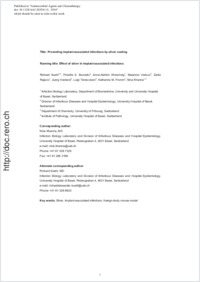Preventing implant-associated infections by silver coating
- Kuehl, Richard Infection Biology Laboratory, Department of Biomedicine, University and University Hospital of Basel, Switzerland - Division of Infectious Diseases and Hospital Epidemiology, University Hospital of Basel, Switzerland
- Brunetto, Priscilla S. Department of Chemistry, University of Fribourg, Switzerland
- Woischnig, Anne-Kathrin Infection Biology Laboratory, Department of Biomedicine, University and University Hospital of Basel, Switzerland
- Varisco, Massimo Department of Chemistry, University of Fribourg, Switzerland
- Rajacic, Zarko Infection Biology Laboratory, Department of Biomedicine, University and University Hospital of Basel, Switzerland
- Vosbeck, Juerg Institute of Pathology, University Hospital of Basel, Switzerland
- Terracciano, Luigi Institute of Pathology, University Hospital of Basel, Switzerland
- Fromm, Katharina M. Department of Chemistry, University of Fribourg, Switzerland
- Khanna, Nina Infection Biology Laboratory, Department of Biomedicine, University and University Hospital of Basel, Switzerland - Division of Infectious Diseases and Hospital Epidemiology, University Hospital of Basel, Switzerland
-
16.02.2016
Published in:
- Antimicrobial Agents and Chemotherapy. - 2016, p. AAC.02934–15
English
Implant-associated infections (IAI) are a dreaded complication mainly caused by biofilm-forming staphylococci. Implant surfaces preventing microbial colonization would be desirable. We examined the preventive effect of a silver-coated titanium aluminium niobium (TiAlNb) alloy. The surface elicited a strong, inoculum-dependent activity against Staphylococcus (S.) epidermidis and S. aureus in an agar inhibition assay. Gamma sterilization and alcohol disinfection did not alter the effect. In a tissue cage mouse model, silver coating of TiAlNb cages prevented peri-operative infections in an inoculum-dependent manner, and led to a 100 % prevention rate after challenge with 2 x 106 CFU S. epidermidis/cage. In S. aureus infections, silver coating had only limited effect. Similarly, daptomycin or vancomycin prophylaxis alone did not prevent S. aureus infections. However, silver coating combined with daptomycin or vancomycin prophylaxis thwarted methicillin-resistant S. aureus infections in 100 % or 33%, respectively. Moreover, silver release from the surface was independent of infection and occurred rapidly after implantation. On day 2, a peak of 82 μg Ag/ml was reached in the cage fluid corresponding to almost 6 times the minimal inhibitory concentration of the staphylococci. Cytotoxicity towards leukocytes in the cage was low and temporary. Surrounding tissue did not reveal histological signs of silver toxicity. In vitro, no emergence of silver resistance was observed in several clinical strains of staphylococci upon serial subinhibitory silver exposure. In conclusion, our data demonstrate that silver-coated TiAlNb is potent for preventing IAI and thus can be considered for clinical application.
- Faculty
- Faculté des sciences et de médecine
- Department
- Département de Chimie
- Language
-
- English
- Classification
- Pathology, clinical medicine
- License
-
License undefined
- Identifiers
-
- RERO DOC 258828
- DOI 10.1128/AAC.02934-15
- Persistent URL
- https://folia.unifr.ch/unifr/documents/304934
Statistics
Document views: 152
File downloads:
- pdf: 355
